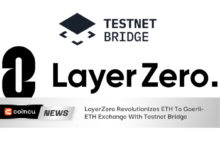Crypto Traders Are Already Placing Bets on Ethereum’s ‘Shanghai Hard Fork’

Ethereum’s historic shift last year to a proof-of-stake network – known as “the Merge” – was one of the biggest stories of the year in crypto markets.
Now all eyes are on Ethereum’s next major upgrade expected to take place in March, known as the “Shanghai hard fork,” which will allow participants on the network to unlock ether (ETH) they had staked on the blockchain, inaccessible for months.
The decision to push forward with Shanghai was announced in December, overshadowed at the time by sour sentiment as the crypto industry dealt with fallout from the epic collapse of Sam Bankman-Fried’s FTX exchange.
A new year has arrived, perhaps bringing a clean slate, and crypto analysts are sharpening their pencils on how ether might trade through Ethereum’s next big milestone.
Ether was recently trading up 12% so far in 2023 to $1,410. Several governance tokens of top liquid staking products also rallied, with Lido DAO (LDO) jumping 53% in the past seven days and 92% in the past 30 days, according to data from CoinGecko.
But the uncertainty regarding Ethereum’s upgrade has also been floating around the market, with some traders commenting on the blockchain’s current low staking ratio compared to other proof-of-stake blockchains. Will ETH stakers dump their tokens on the open market once they’re unlocked, or will they double down in a new era of widespread blockchain staking?
“The Merge was an important milestone and achievement for Ethereum,” Coin Metrics wrote in a newsletter note. “But in 2023 Ethereum ecosystem participants will also continue to grapple with the complex dynamics of proof of stake.”
CoinDesk spoke with five crypto traders and analysts to compile their key thoughts and predictions on the market impact of the Shanghai upgrade.
Crypto trader Thomas Kralow expects to see a short-term downside move for ETH right before and following the upgrade due to “the daily liquidity not keeping up with the supply of unstaked ETH.” He also notes “the fact that April is the deadline for taxes, which won’t help either because a lot of selling usually takes place during the tax period.” He predicted that the potential price drop wouldn’t amount to more than 15%-20% and that ETH should recover rapidly. According to Kralow, the Shanghai upgrade, if successful, will lay the foundation for another significant scaling upgrade – proto-danksharding, also known as EIP 4844 – later this year, which would make Ethereum more scalable through sharding. “Needless to say that such improvements will be incredibly bullish for Ethereum, and any short-term selling pressure will be bought up either entirely or at least partially,” he said.
Jeff Dorman, chief investment officer at the digital-asset management firm Arca: “Most investors have heard of blockchain now and want to somehow make money if blockchain succeeds. For the last five years, almost every investor has tried to find different ways to express that theme. But for the first time ever, we’re coming out of a bear market with real product market fit,” which includes four areas: bitcoin, stablecoins, non-fungible tokens (NFTs) and decentralized finance (DeFi). “If you want to express all of those areas of blockchain with one investment, it would be Ethereum. It has wrapped bitcoin, the largest stablecoin presence, the largest NFT presence and the largest DeFi presence,” he said, adding: “In some ways, ETH is basically a crypto index now.” Dorman said he wouldn’t worry about the potential sell-off pressure from unlocking staked ETH following the upgrade: “There might be some pent-up demand to get liquidity from those who have had no liquidity for the last six or so months, but that will easily be replaced by people who didn’t stake the first time because they needed liquidity.”
Lucas Outumuro, head of research at crypto data and analysis firm IntoTheBlock, wrote in a newsletter that ETH withdrawals will be processed through a queue with a maximum of approximately 43,000 staked ETH allowed to exit per day. “Based on this, it would take over a year for the 15.91 million ETH staked to be withdrawn, preventing mass withdrawals and mitigating selling pressure,” he said. “The fact that people staking may now be able to withdraw, even if they have to form part of a queue, could in turn encourage more people to stake.”
Kunal Goel, Messari’s research analyst, wrote in a report that the total amount of ether staked will likely increase post-Shanghai. Goel pointed out that Ethereum remains the lowest staking ratio compared to other major proof-of-stake chains (The staking ratio of other significant chains ranges between 46% and 97%). After the Shanghai upgrade, a range of 30-50% of Ethereum’s staking ratio “seems reasonable.” He also predicted that liquid staking protocols Lido and Rocket Pool will benefit from an increase in ETH’s staking ratio after Shanghai, while decentralized trustless protocols should see secular growth.
Brent Xu, founder and CEO at Cosmos-based borrowing and lending platform Umee, expected “some sell pressure” after the Shanghai upgrade. He said similar to Cosmos, Ethereum’s liquid staking derivatives currently face centralization risks that “not everyone trusts them,” though he expected after Shanghai upgrade, liquid staking derivatives will “significantly de-risk” ETH’s staking. He added: «This is a dance between the proof-of-stake protocol readiness and how decentralized and how trusting people are of liquid staking protocols.”






 Bitcoin
Bitcoin  Ethereum
Ethereum  Tether
Tether  USDC
USDC  TRON
TRON  Dogecoin
Dogecoin  Cardano
Cardano  Bitcoin Cash
Bitcoin Cash  Chainlink
Chainlink  LEO Token
LEO Token  Monero
Monero  Stellar
Stellar  Zcash
Zcash  Litecoin
Litecoin  Hedera
Hedera  Dai
Dai  Cronos
Cronos  OKB
OKB  Tether Gold
Tether Gold  Ethereum Classic
Ethereum Classic  KuCoin
KuCoin  Gate
Gate  Algorand
Algorand  Cosmos Hub
Cosmos Hub  VeChain
VeChain  Dash
Dash  Tezos
Tezos  Stacks
Stacks  TrueUSD
TrueUSD  IOTA
IOTA  Basic Attention
Basic Attention  Theta Network
Theta Network  Decred
Decred  NEO
NEO  Qtum
Qtum  Synthetix
Synthetix  Ravencoin
Ravencoin  0x Protocol
0x Protocol  DigiByte
DigiByte  Zilliqa
Zilliqa  Nano
Nano  Siacoin
Siacoin  Numeraire
Numeraire  Waves
Waves  Ontology
Ontology  Enjin Coin
Enjin Coin  Status
Status  BUSD
BUSD  Hive
Hive  Pax Dollar
Pax Dollar  Lisk
Lisk  Steem
Steem  Huobi
Huobi  NEM
NEM  OMG Network
OMG Network  Bitcoin Gold
Bitcoin Gold  Augur
Augur  Bitcoin Diamond
Bitcoin Diamond  Ren
Ren